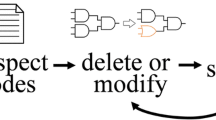Abstract
Malicious modifications of integrated circuits have emerged as a potent threat to circuit and system security and reliability. In this paper, we present theoretical models of different types of commonly investigated malicious hardware logic to estimate their effect on circuit reliability, specifically those malicious circuit modifications that cause functional failure of circuits (“hardware Trojans”). Simulation results show close match to the theoretically predicted trends.
Access this chapter
Tax calculation will be finalised at checkout
Purchases are for personal use only
Preview
Unable to display preview. Download preview PDF.
Similar content being viewed by others
References
Karri, R., Rajendran, J., Rosenfeld, K., Tehranipoor, M.: Trustworthy hardware: identifying and classifying hardware Trojans. IEEE Computer 43(10), 39–46 (2010)
Huffmire, T., Irvine, C., Nguyen, T.D., Levin, T., Kastner, R., Sherwood, T.: Handbook of FPGA Design Security. Springer, Dordrecht (2010)
Aarestad, J., Acharyya, D., Rad, R., Plusquellic, J.: Detecting Trojans through leakage current analysis using multiple supply pad IDDQ. IEEE Trans. Inf. Forensics Security 5(4), 893–904 (2010)
Rad, R., Plusquellic, J., Tehranipoor, M.: A sensitivity analysis of power signal methods for detecting hardware Trojans under real process and environmental conditions. IEEE Trans. VLSI Syst. 18(12), 1735–1744 (2010)
Koushanfar, F., Mirhoseini, A.: A unified framework for multimodal submodular integrated circuits Trojan detection. IEEE Trans. Inf. Forensics Security 6(1), 162–174 (2011)
Potkonjak, M., Nahapetian, A., Nelson, M., Massey, T.: Hardware Trojan horse detection using gate-level characterization. In: Proc. Design Automation Conference (DAC 2009), pp. 688–693 (2009)
Banga, M., Hsiao, M.S.: A region based approach for the identification of hardware Trojans. In: Proc. IEEE International Workshop on Hardware-Oriented Security and Trust (HOST 2008), pp. 40–47 (2008)
Koren, I., Krishna, C.M.: Fault–tolerant Systems. Morgan Kaufmann Publishers, Francisco (2007)
Author information
Authors and Affiliations
Editor information
Editors and Affiliations
Rights and permissions
Copyright information
© 2012 Springer-Verlag Berlin Heidelberg
About this paper
Cite this paper
Burman, S., Palchaudhuri, A., Chakraborty, R.S., Mukhopadhyay, D., Singh, P. (2012). Effect of Malicious Hardware Logic on Circuit Reliability. In: Rahaman, H., Chattopadhyay, S., Chattopadhyay, S. (eds) Progress in VLSI Design and Test. Lecture Notes in Computer Science, vol 7373. Springer, Berlin, Heidelberg. https://doi.org/10.1007/978-3-642-31494-0_22
Download citation
DOI: https://doi.org/10.1007/978-3-642-31494-0_22
Publisher Name: Springer, Berlin, Heidelberg
Print ISBN: 978-3-642-31493-3
Online ISBN: 978-3-642-31494-0
eBook Packages: Computer ScienceComputer Science (R0)



